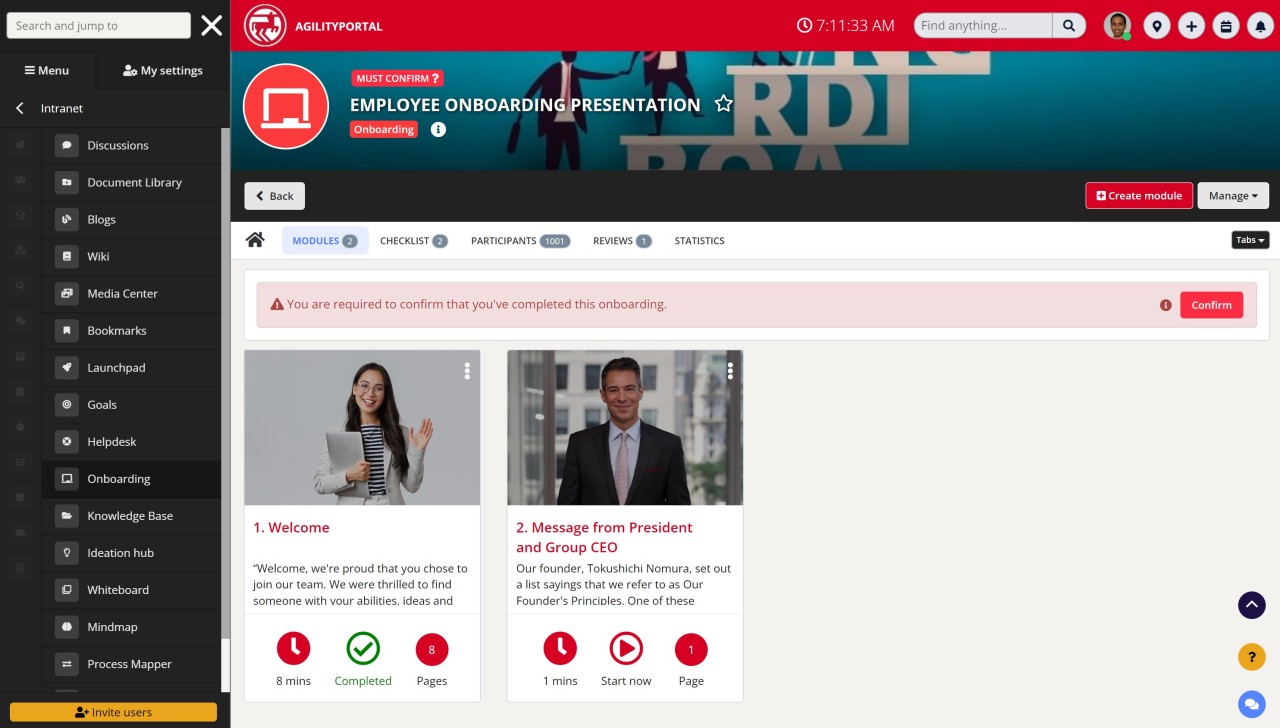Insight Blog
Agility’s perspectives on transforming the employee's experience throughout remote transformation using connected enterprise tools.
9 minutes reading time
(1841 words)
What is employee onboarding? The role of HR and its benefits for an organization
Employee onboarding at the majority of organizations focuses on completing new hire paperwork and explaining processes. What is employee onboarding?
When we talk about "onboarding," we're referring to the steps used to welcome new employees into an existing group. It consists of exercises designed to familiarize new hires with the company's structure, culture, vision, goal, and values. Some companies' onboarding processes are brief and just take a day or two, while for others, it can take several weeks.
What is employee onboarding?
Employee onboarding is the process of orienting and acclimating new employees to their job and work environment. The goal of onboarding is to help new hires adjust to their new role and become productive members of the team as quickly as possible.
An effective onboarding program will cover all of the essential information that new employees need to know, including the company's history, culture, values, and mission. It will also provide an overview of the new hire's job responsibilities, expectations, and goals. In addition, an onboarding program should give new employees a chance to meet their colleagues and learn about the company's procedures and policies.
Statistics:
- A survey said that 88% of organizations don't onboard well. (Sapling HR, 2021)
- People who had a lousy onboarding experience were twice as likely to leave the firm (Clickboarding, 2020)
- 93% of employers believe a good onboarding experience is critical in influencing a new employee's decision whether to stay with the company. (CareerBuilder, 2018).
By taking the time to effectively onboard new hires, companies can help ensure that they are setting their employees up for success from day one.
Orientation is commonly used as a synonym for "onboarding." Onboarding is a complete procedure that involves management and other employees and can last up to 12 months, whereas orientation is important for completing paperwork and other routine activities.
Every new hire undergoes some sort of "onboarding," although the effectiveness of this process varies. Onboarding is often reduced to a supervisor or HR professional showing a new hire around the office and haphazardly introducing them to everyone they might need to know.
However, when onboarding is executed properly using a new hire checklist, it paves the way for both the individual and the company's long-term success. It has the potential to boost output, boost employee loyalty and engagement, and aid in the early career success of new hires.
Employee onboarding process
The term "onboarding" refers to the steps taken to acclimate new employees to their workplace. But the time it takes to get there could be different from company to company.
Some companies have an intensive 18-month onboarding process, while others believe it should only take a day. Even so, the onboarding process for new hires typically begins soon after an offer letter is extended.
Have a look at this comprehensive breakdown of the onboarding procedure.
- Start with the basics. Make sure that new hires have all the information they need to understand their roles and responsibilities. This includes things like job descriptions, organizational charts, and company policies.
- Introduce them to the team. A big part of feeling comfortable in a new job is feeling like you belong to the team. Help facilitate this by introductions and icebreakers on the first day, and continue to foster a sense of community throughout the onboarding process.
- Set expectations early. It's important that new hires know what is expected of them in terms of both performance and conduct. By setting clear expectations from the start, you'll help ensure that everyone is on the same page from Day One.
- Provide resources and support. New hires will likely have questions throughout the onboarding process (and beyond). Make sure they know whom to ask for help, and provide them with any resources they might need, such as a company handbook or an intranet site.
- Follow up after Day One. The end of the first day is just the beginning of the onboarding process. Check in with new hires periodically over their first few weeks on the job to see how they're doing and if they have any questions or concerns.
The role of HR leaders in the employee onboarding process
Human resources leaders play an important role in the employee onboarding process. By working with new hires to ensure they have the tools and information they need to be successful in their new roles, HR leaders can help to set the stage for a productive and long-lasting relationship between employees and their employer.
One of the most important things HR leaders can do is to clearly communicate expectations.
From the start, new hires should know what is expected of them in terms of job performance, attendance, and conduct. In addition, HR leaders should provide new hires with a detailed overview of company policies and procedures.
By taking the time to ensure that new employees have a strong foundation, HR leaders can help to ensure a smooth transition into the workplace.
The key to retention, early engagement, and long-term loyalty is a well-designed onboarding program.
The likelihood that a new hire will become an efficient, long-term contributor to the organization increases with the quality of their onboarding experience. It's more cost-effective to keep an existing worker than to find a new one, so it's smart to hire well from the start.
What can HR do to make sure new hires get off to a good start?
It's advisable to send a new hire a welcome email with the following information before their first day of work.
- When shall I be there
- The appropriate level of formal attire
- Parking area
- Who to see when I get there
- Adopt an intranet to facilitate your onboarding like AgilityPortal
HR can also send a handwritten note of introduction along with a little token of appreciation to help smooth the transition into the firm and the team.
Human resources can organize an orientation for new hires on their first day to familiarize them with the company's goals and ethos. Human resources can do even more for a new hire by pairing them with a "buddy" who can help them adjust to work life and learn the ropes of the organization.
Human resources should also give new employees all the login credentials, website addresses, digital business cards with two way contact sharing features for networking and other information they need to get started in their new position.
An HR manager can keep in touch with a new recruit weekly for the first three months to make sure they are settling in well and are clear on their roles and duties.
How can successful onboarding improve company culture?
The onboarding process prepares new employees for success in their new roles and environments. A new employee will appreciate a well-thought-out onboarding process in much the same way as a nervous child will appreciate a warm welcome on the first day of kindergarten.
The onboarding phase of working with a new hire is the beginning of a fruitful and productive partnership. New hires that experience a positive onboarding process are more likely to remain with the company, be productive, and be happy in their roles.
In the long run, a strong and positive corporate culture is the result of early and consistent attention to the requirements of its employees.
Benefits of using an employee onboarding strategy
Making the deal public
Following the hiring process is the beginning of the onboarding procedure. Once an applicant has been selected, the HR manager will send a pleasant welcome email with links to important papers such as the offer letter, digital onboarding forms, and policy documents.
The more open the method, the more the employee will understand the company's culture and what they may expect from their role.
Acceptance of an offer
The finest companies will plan a brief conversation with the new hire shortly after they accept the offer to go over paperwork, policies, and expectations.
Keeping new hires interested will reinforce their decision to accept the offer and help them form strong emotional links to the company. The time to begin outlining the schedule for new hire orientation has arrived.
Waiting to join
No assurance can be given that the person will really show up for the scheduled start date of employment simply because they accepted the offer. The employee may be exposed to offers from other companies during the waiting time.
For this reason, getting along well with the worker is essential. A valued employee deserves to know how much you appreciate them. When developing your staff onboarding process, it's a good idea to also consider the waiting period.
Joining
Most new hires experience a range of emotions on their first day. At the same time, they are apprehensive, delighted, excited, and nervous.
Thus, HR managers should prioritize making their new hires feel at ease. New hires will be more dedicated to their jobs and more productive if they feel welcome and part of the team.
Departmental coordination
A new hire's start date must be coordinated with and communicated to all relevant parties (coworkers and management).
Human resources may ask other workers to help with the new hire's cubicle decoration, one-on-one meeting preparation, and orientation program.
Orientation and providing training
Orientation workshops give the new hire an overview of the organization's culture and an insight into company goals. Here, new employees can learn about the various departments, processes, and policies that make up the firm as a whole.
It is a good moment to demonstrate to new hires what they need to concentrate on by establishing role-based goals and objectives for the following months.
The first three months
The primary goal at this stage is to evaluate whether organizational and individual goals are aligned. This alignment ensures that new hires can effectively contribute to the company's objectives while fostering their personal growth.
During this time, managers and new hires should engage in regular discussions about the latter's efforts to integrate into the company's culture. Open communication helps identify potential challenges early and creates opportunities for feedback, fostering a smoother transition.
Similarly, professional development tools like PHR Certification Practice Test Dumps can be introduced to support employees in aligning their career growth with organizational goals. By integrating learning opportunities into onboarding and development plans, companies can empower new hires to thrive in their roles while advancing shared objectives.
Alignment of goals not only enhances individual engagement but also drives organizational success, creating a foundation for long-term collaboration.
Categories
Blog
(2622)
Business Management
(323)
Employee Engagement
(212)
Digital Transformation
(176)
Growth
(119)
Intranets
(116)
Remote Work
(61)
Sales
(48)
Collaboration
(36)
Project management
(29)
Culture
(28)
Customer Experience
(26)
Knowledge Management
(21)
Leadership
(20)
Comparisons
(6)
News
(1)
Ready to learn more? 👍
One platform to optimize, manage and track all of your teams. Your new digital workplace is a click away. 🚀
Free for 14 days, no credit card required.













![What Is an Intranet for Business? [2026 Guide] What Is an Intranet for Business? [2026 Guide]](http://agilityportal.io/images/easyblog_articles/1496/b2ap3_thumbnail_What-Is-an-Intranet-for-Business.png)


